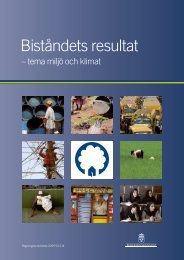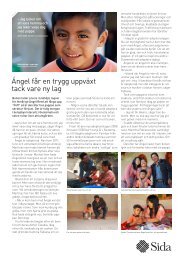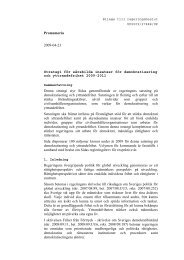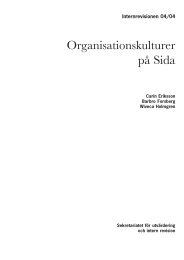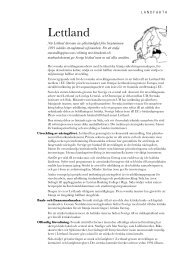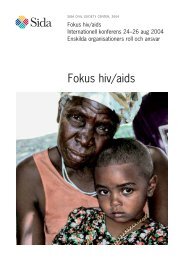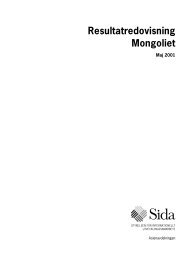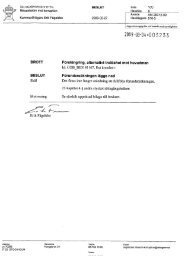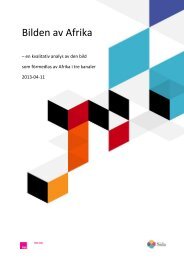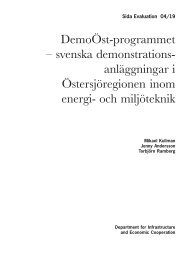Mid-Term Review of the AGIR Programme - Sida
Mid-Term Review of the AGIR Programme - Sida
Mid-Term Review of the AGIR Programme - Sida
You also want an ePaper? Increase the reach of your titles
YUMPU automatically turns print PDFs into web optimized ePapers that Google loves.
2 F I N D I N G S<br />
Akilizetho has a history <strong>of</strong> gender mainstreaming practices but, with <strong>the</strong> support<br />
<strong>of</strong> <strong>the</strong> <strong>AGIR</strong> programme, <strong>the</strong>ir approach has improved and has become<br />
more technically pr<strong>of</strong>icient. The training activities were also a good opportunity<br />
for networking, which allowed Akilizetho to have access to materials<br />
and information on many <strong>the</strong>mes on gender from lead organisations in <strong>the</strong><br />
field (in this case, WLSA and Forum Mulher).<br />
The inclusion <strong>of</strong> gender, HIV/AIDS and human rights elements in <strong>the</strong> interventions<br />
<strong>of</strong> <strong>the</strong> OE is considered to be a key result <strong>of</strong> <strong>AGIR</strong> support. The recruitment<br />
process for OE projects requires that 50% <strong>of</strong> <strong>the</strong> recruited staff are<br />
women, although this is not always achieved, due to capacity imbalances. For<br />
example, most <strong>of</strong> <strong>the</strong> provincial coordinators (80%) are men. Among electoral<br />
observers this ratio is also low; <strong>the</strong> justification for this is that electoral observation<br />
involves physical hardship that few women will accept. Human<br />
rights are seen as a basic element in <strong>the</strong>ir work and electoral participation is<br />
among <strong>the</strong>m. The observatory also takes advantage <strong>of</strong> having, among its<br />
members, <strong>the</strong> LDH to ensure that human rights are mainstreamed in <strong>the</strong>ir interventions.<br />
At ORAM, gender is in <strong>the</strong>ir strategic plan and in its interventions are also<br />
combined with human rights. For example, in <strong>the</strong> database created on land<br />
rights, <strong>the</strong>y included information with DUAT (Land Certificate), who are<br />
more vulnerable to rights’ violation.<br />
Only a few organisations have formal structures concerning gender. Most <strong>of</strong>ten, management<br />
and programmatic practices exist that contribute to <strong>the</strong> mainstreaming <strong>of</strong><br />
cross-cutting areas such as gender. Some examples are:<br />
Organisations, such as Akilizetho and Juvenile Parliament have specific structures<br />
to mainstream gender issues. In <strong>the</strong> PJ, <strong>the</strong>re is a specific area <strong>of</strong> Gender<br />
and Human Rights in <strong>the</strong>ir internal structure.<br />
Many <strong>of</strong> <strong>the</strong> CSO partners have designated specific individuals in <strong>the</strong>ir organisations<br />
to monitor gender-related activities: In Akilizetho a specific gender<br />
<strong>of</strong>ficer is responsible for this area <strong>of</strong> mainstreaming <strong>the</strong>se elements in <strong>the</strong> organisation’s<br />
programming. A programme <strong>of</strong>ficer with ORAM performs <strong>the</strong><br />
same role, while <strong>the</strong> OE has two programme <strong>of</strong>ficers responsible for ensuring<br />
that gender policies are incorporated in <strong>the</strong>ir actions. At each ORAM branch,<br />
<strong>the</strong> staff responsible for <strong>the</strong> planning and monitoring <strong>of</strong> programmatic areas<br />
are also responsible for tracking gender mainstreaming in all relevant areas.<br />
At ACAMO, <strong>the</strong> Departments <strong>of</strong> Woman and Children and <strong>of</strong> Social and Legal<br />
Assistance deal with gender and human rights issues respectively. However,<br />
<strong>the</strong>se were not created under <strong>AGIR</strong>.<br />
According to <strong>the</strong> Joint Outcome Matrix published in Oxfam’s annual report for 2011,<br />
<strong>the</strong> foreseen joint outcomes and respective indicators for gender and HIV/AIDS by<br />
2014 are:<br />
Joint Outcome 5.1.4: Internal systems and policies in gender and HIV/AIDS<br />
create a safe working environment in partner organisations. To be achieved by<br />
<strong>the</strong> following indicators:<br />
i) Key Partners have an implemented and operational gender policy<br />
ii) Key Partners have an implemented and operational HIV/AIDS policy<br />
63




